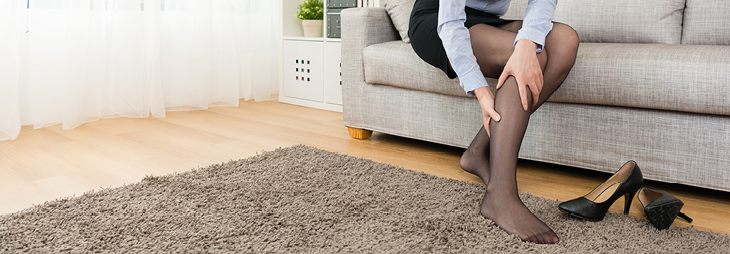
 If your legs ache, swell or simply don’t feel right, they could be signaling a potential (but fixable) problem. Your veins take the nutrients you need from your blood and then recirculate it back to the heart to be reoxygenated. This system requires a pump in the calf muscle but mostly relies on a valve system — it’s mechanical, working against gravity all day long. One common leg problem is venous insufficiency. This occurs when the valves in the veins have trouble sending blood from the legs back to the heart. This can result in some pooling in the legs, which ultimately leads to swelling.
If your legs ache, swell or simply don’t feel right, they could be signaling a potential (but fixable) problem. Your veins take the nutrients you need from your blood and then recirculate it back to the heart to be reoxygenated. This system requires a pump in the calf muscle but mostly relies on a valve system — it’s mechanical, working against gravity all day long. One common leg problem is venous insufficiency. This occurs when the valves in the veins have trouble sending blood from the legs back to the heart. This can result in some pooling in the legs, which ultimately leads to swelling.
“Every day when you take off the socks and shoes and you have that sock line, then when you go to bed, get off your feet, everything looks good in the morning,” said Dee White, APRN and Clinical Director of the Vein and Vascular Institute. “You get up and put on the cute strappy sandals and by afternoon you’re thinking, ‘What was I thinking? Because now I have cankles.’ This is what you see. It’s dependent type edema.”
Venous insufficiency can be diagnosed with a physical exam. It’s also important to know the timing of the edema and distribution, which is generally ankle up.
“We don’t see a lot of venous insufficiency that’s in the toes and feet like you would with lymphedema,” White said. “Patients will have a history of when they elevate their feet, they feel fine because the swelling resolves. We hear patients say they have heaviness during the day, like they’re dragging tree trunks. That’s how we make the diagnosis.” After a venous insufficiency diagnosis, White’s team at the Vein and Vascular Institute uses specific tools like ultrasound to see where the venous insufficiency is located and whether a more aggressive or conservative treatment plan is required.
One conservative treatment White recommends to patients of all ages is using compression for support. Anyone can benefit from using compression socks, sleeves and more — whether you spend most of your day sitting down or on your feet, compression can alleviate the buildup that eventually leads to venous insufficiency.
Venous insufficiency can impact anyone — men, women, teenagers and senior citizens alike. Patients typically notice swelling followed by pain at the onset of venous insufficiency.
Venous insufficiency can also lead to venous ulcers –rusty, dark, leathery, cracked ulcers that won’t heal on the skin. Patients with venous ulcers are repeatedly suffering from infections because their wounds won’t heal due to pressure behind them. Doctors will work to heal these ulcers by removing the pressure.
White recommends if you notice swelling, talk to your provider. “If it’s not your heart and not your medications, it’s probably your circulation.”
For more information, check out our vein and vascular services.